Atmospheric Gravity Wave Potential Energy Observed by Rayleigh Lidar above Jiuquan (40° N, 95° E), China
Abstract
:1. Introduction
2. Data and Analysis Methods
2.1. Rayleigh Lidar and Data
2.2. Extraction Method of Temperature Perturbations
- Eliminate the temperature data with uncertainty higher than 10 K to retain the data with higher reliability.
- Fit a straight line to the temperature temporal series for each altitude during the nocturnal observation to obtain the background temperature.
- Obtain the temperature perturbation by subtracting the background temperature from the measured temperature.
2.3. Calculation of GWPED and Scale Height
3. Results and Analysis of GWPED
4. Discussion
5. Conclusions
Author Contributions
Funding
Institutional Review Board Statement
Informed Consent Statement
Conflicts of Interest
References
- Fritts, D.C.; Alexander, M.J. Gravity wave dynamics and effects in the middle atmosphere. Rev. Geophys. 2003, 41, 1003. [Google Scholar] [CrossRef] [Green Version]
- Preusse, P.; Eckermann, S.; Ern, M. Transparency of the atmosphere to short horizontal wavelength gravity waves. J. Geophys. Res. Earth Surf. 2008, 113, D24104. [Google Scholar] [CrossRef]
- Wilson, R.; Chanin, M.L.; Hauchecorne, A. Gravity waves in the middle atmosphere observed by Rayleigh lidar: 1. Case studies. J. Geophys. Res. Earth Surf. 1991, 96, 5153. [Google Scholar] [CrossRef]
- Llamedo, P.; Salvador, J.; de la Torre, A.; Quiroga, J.; Alexander, P.; Hierro, R.; Schmidt, T.; Pazmiño, A.; Quel, E. 11 Years of Rayleigh Lidar Observations of Gravity Wave Activity Above the Southern Tip of South America. J. Geophys. Res. Atmos. 2019, 124, 451–467. [Google Scholar] [CrossRef]
- Rauthe, M.; Gerding, M.; Höffner, J.; Lübken, F.-J. Lidar temperature measurements of gravity waves over Kühlungsborn (54° N) from 1 to 105 km: A winter-summer comparison. J. Geophys. Res. Earth Surf. 2006, 111, D24108. [Google Scholar] [CrossRef]
- Alpers, M.; Eixmann, R.; Fricke–Begemann, C.; Gerding, M.; Höffner, J. Temperature lidar measurements from 1 to 105 km altitude using resonance, Rayleigh, and Rotational Raman scattering. Atmos. Chem. Phys. 2004, 4, 793–800. [Google Scholar] [CrossRef] [Green Version]
- Cai, X.; Yuan, T.; Liu, H.L. Large Scale Gravity Waves perturbations in mesosphere region above northern hemisphere mid–latitude during Autumn–equinox: A joint study by Na Lidar and Whole Atmosphere Community Climate Model. Ann. Geophys. 2017, 35, 181–188. [Google Scholar] [CrossRef] [Green Version]
- Chu, X.; Zhao, J.; Lu, X.; Harvey, V.L.; Jones, R.M.; Becker, E.; Chen, C.; Fong, W.; Yu, Z.; Roberts, B.R.; et al. Lidar Observations of Stratospheric Gravity Waves From 2011 to 2015 at McMurdo (77.84° S, 166.69° E), Antarctica: 2. Potential Energy Densities, Lognormal Distributions, and Seasonal Variations. J. Geophys. Res. Atmos. 2018, 123, 7910–7934. [Google Scholar] [CrossRef] [Green Version]
- Wilson, R.; Chanin, M.L.; Hauchecorne, A. Gravity waves in the middle atmosphere observed by Rayleigh lidar: 2. Climatology. J. Geophys. Res. Earth Surf. 1991, 96, 5169. [Google Scholar] [CrossRef]
- Whiteway, J.A.; Carswell, A.I. Lidar observations of gravity wave activity in the upper stratosphere over Toronto. J. Geophys. Res. Earth Surf. 1995, 100, 14113–14124. [Google Scholar] [CrossRef]
- Sivakumar, V.; Rao, P.B.; Bencherif, H. Lidar observations of middle atmospheric gravity wave activity over a low–latitude site (Gadanki, 13.5° N, 79.2° E). Ann. Geophys. 2006, 24, 823–834. [Google Scholar] [CrossRef] [Green Version]
- Thurairajah, B.; Collins, R.L.; Harvey, V.L.; Lieberman, R.S.; Mizutani, K. Rayleigh lidar observations of reduced gravity wave activity during the formation of an elevated stratopause in 2004 at Chatanika, Alaska (65° N, 147° W). J. Geophys. Res. Earth Surf. 2010, 115, D13109. [Google Scholar] [CrossRef] [Green Version]
- Kafle, D.N. Rayleigh-Lidar Observations of Mesospheric Gravity Wave Activity above Logan; Utah State University: Logan, UT, USA, 2009. [Google Scholar]
- Mzé, N.; Hauchecorne, A.; Keckhut, P.; Thétis, M. Vertical distribution of gravity wave potential energy from long–term Rayleigh lidar data at a northern middle-latitude site. J. Geophys. Res. Atmos. 2014, 119, 12069–12083. [Google Scholar] [CrossRef]
- Wenjie, G.U.O.; Zhaoai, Y.A.N.; Xiong, H.U.; Shangyong, G.U.O.; Yongqiang, C.H.E.N.G.; Wenze, H.A.O. Seasonal Variation of Atmospheric Temperature and Gravity Wave Activity over Beijing Area. Chin. J. Space Sci. 2017, 37, 177–184. [Google Scholar]
- Chen, C. The Preliminary studies on the gravity waves of mid–Atmosphere through Rayleigh Lidar. Master’s Thesis, University of Science and Technology of China, Hefei, China, 2012. [Google Scholar]
- Zhaoai, Y.; Xiong, H.; Wenjie, G.; Shangyong, G.; Yongqiang, C.; Bingyan, Z.; Zhifang, C.; Weibo, Z. Near space Doppler lidar techniques and applications. Infrared Laser Eng. 2021, 50, 36–45. [Google Scholar]
- Gardner, C.S.; Liu, A. Seasonal variations of the vertical fluxes of heat and horizontal momentum in the mesopause region at Starfire Optical Range, New Mexico. J. Geophys. Res. Earth Surf. 2007, 112, D09113. [Google Scholar] [CrossRef] [Green Version]
- Lighthill, J. Waves in Fluids; Cambridge University Press: Cambridge, UK, 1978. [Google Scholar]
- Lu, X.; Chu, X.; Fong, W.; Chen, C.; Yu, Z.; Roberts, B.R.; McDonald, A.J. Vertical evolution of potential energy density and ver-tical wave number spectrum of Antarctic gravity waves from 35 to 105 km at McMurdo (77.8° S, 166.7° E). J. Geophys. Res. Atmos. 2015, 120, 2719–2737. [Google Scholar] [CrossRef]
- Lindzen, R.S. Turbulence and stress owing to gravity wave and tidal breakdown. J. Geophys. Res. Earth Surf. 1981, 86, 9707–9714. [Google Scholar] [CrossRef] [Green Version]
- Yang, J.; Xiao, C.; Hu, X.; Xu, Q. Responses of zonal wind at 40° N to stratospheric sudden warming events in the stratosphere, mesosphere and lower thermosphere. Sci. China Technol. Sci. 2017, 60, 935–945. [Google Scholar] [CrossRef]
- Lee, W.; Song, I.S.; Kim, J.H.; Kim, Y.H.; Jeong, S.H.; Eswaraiah, S.; Murphy, D.J. The observation and SD–WACCM simulation of planetary wave activity in the middle atmosphere during the 2019 southern hemispheric sudden stratospheric warming. J. Geophys. Res. Space Phys. 2021, 126, e2020JA029094. [Google Scholar] [CrossRef]
- Fritts, D.C.; Lu, W. Spectral Estimates of Gravity Wave Energy and Momentum Fluxes. Part II: Parameterization of Wave Forcing and Variability. J. Atmos. Sci. 1993, 50, 3695–3713. [Google Scholar] [CrossRef] [Green Version]
- Zhao, W.; Hu, X.; Pan, W.; Yan, Z.; Guo, W. Mesospheric Gravity Wave Potential Energy Density Observed by Rayleigh Lidar above Golmud (36.25° N, 94.54° E), Tibetan Plateau. Atmosphere 2022, 13, 1084. [Google Scholar] [CrossRef]
- Rauthe, M.; Gerding, M.; Lübken, F.-J. Seasonal changes in gravity wave activity measured by lidars at mid-latitudes. Atmos. Chem. Phys. 2008, 8, 6775–6787. [Google Scholar] [CrossRef] [Green Version]
- Yamashita, C.; Chu, X.; Liu, H.-L.; Espy, P.J.; Nott, G.J.; Huang, W. Stratospheric gravity wave characteristics and seasonal variations observed by lidar at the South Pole and Rothera, Antarctica. J. Geophys. Res. Earth Surf. 2009, 114, D12101. [Google Scholar] [CrossRef] [Green Version]
- Sica, R.J.; Argall, P.S. Seasonal and nightly variations of gravity-wave energy density in the middle atmosphere measured by the Purple Crow Lidar. Ann. Geophys. 2007, 25, 2139–2145. [Google Scholar] [CrossRef]
- Alexander, S.P.; Klekociuk, A.R.; Murphy, D.J. Rayleigh lidar observations of gravity wave activity in the winter upper strat-osphere and lower mesosphere above Davis, Antarctica (69° S, 78° E). J. Geophys. Res. 2011, 116, D13109. [Google Scholar] [CrossRef]
- Kaifler, B.; Lübken, F.J.; Höffner, J.; Morris, R.J.; Viehl, T.P. Lidar observations of gravity wave activity in the middle atmos-phere over Davis (69° S, 78° E), Antarctica. J. Geophys. Res. Atmos. 2015, 120, 4506–4521. [Google Scholar] [CrossRef] [Green Version]
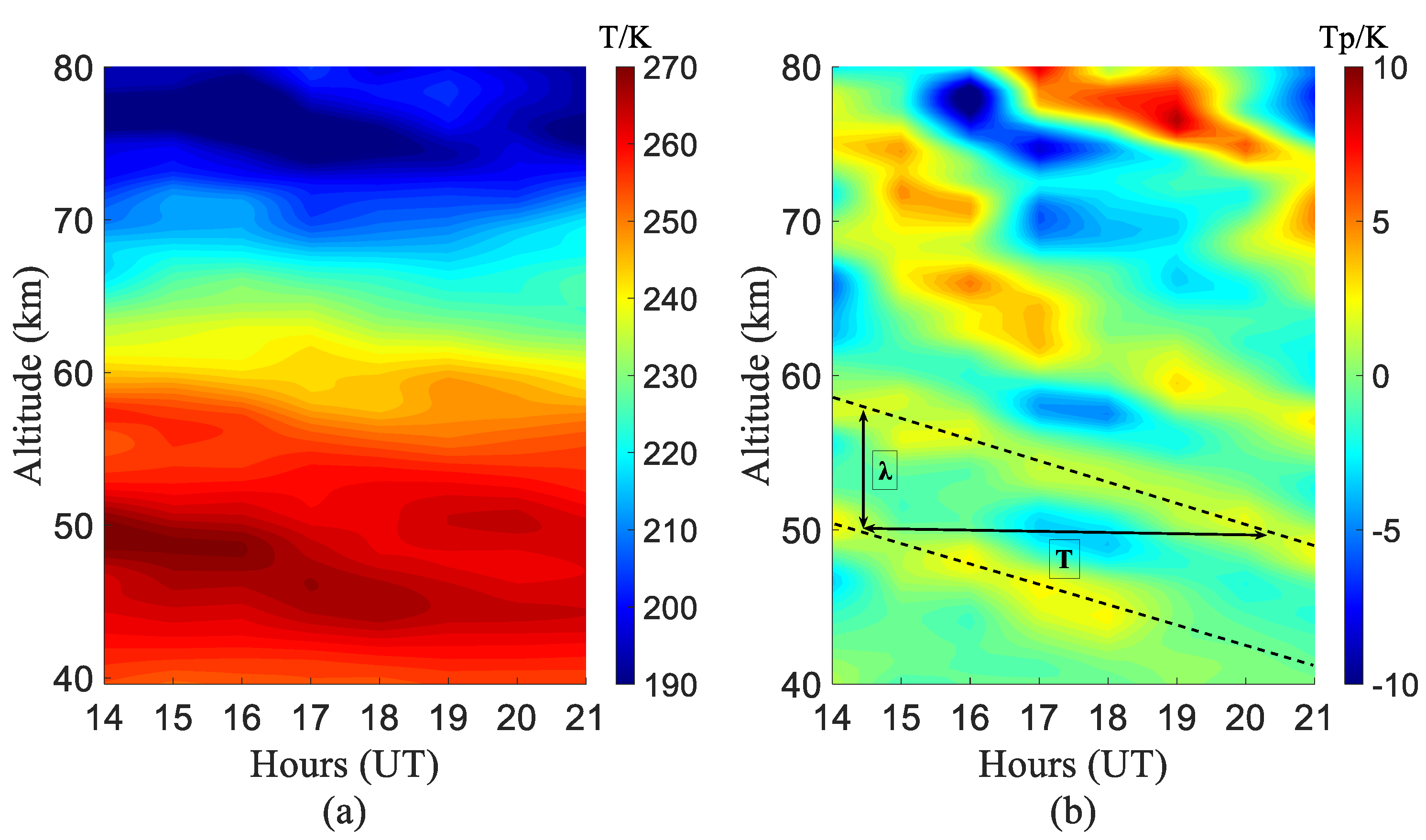
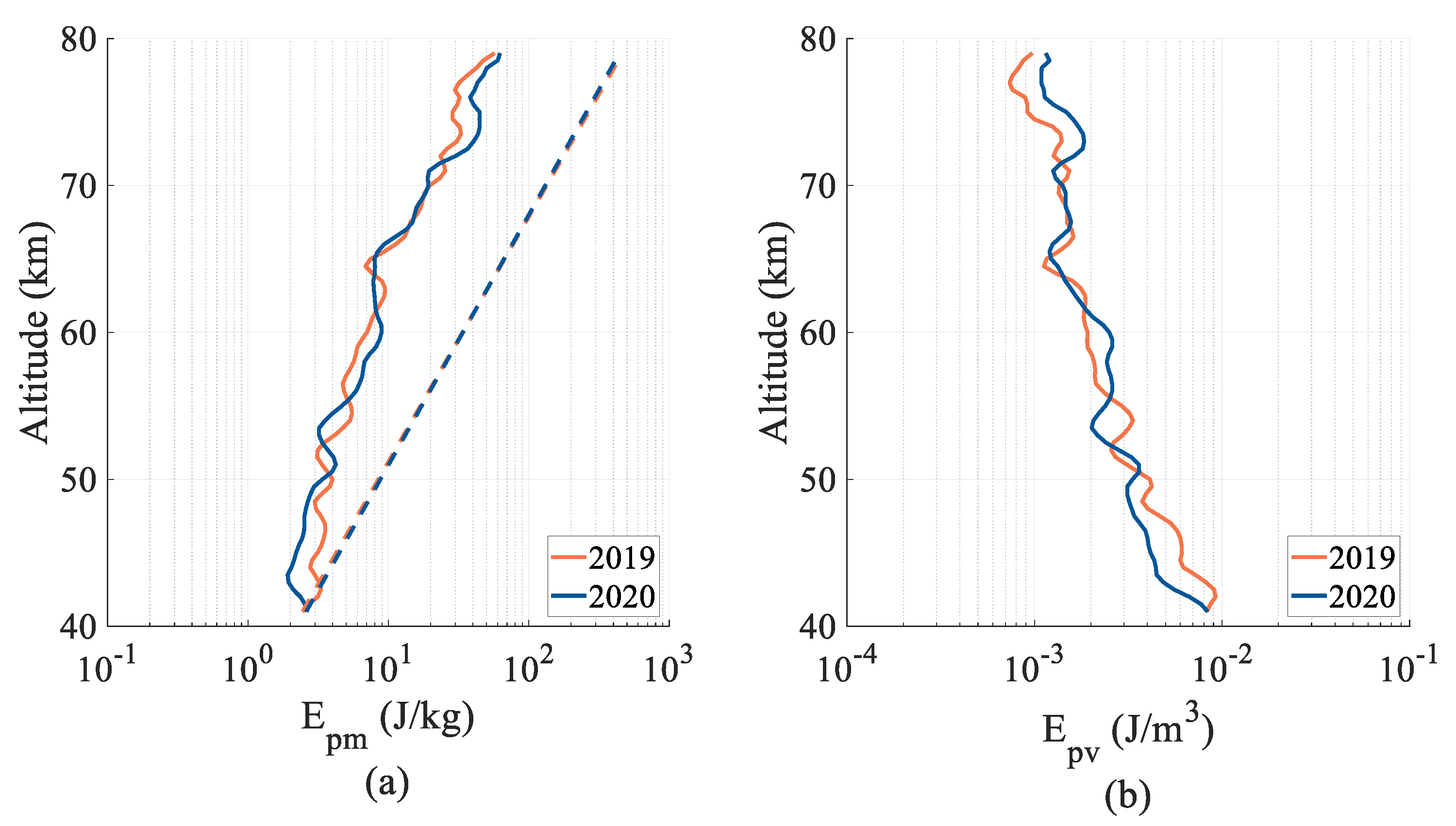
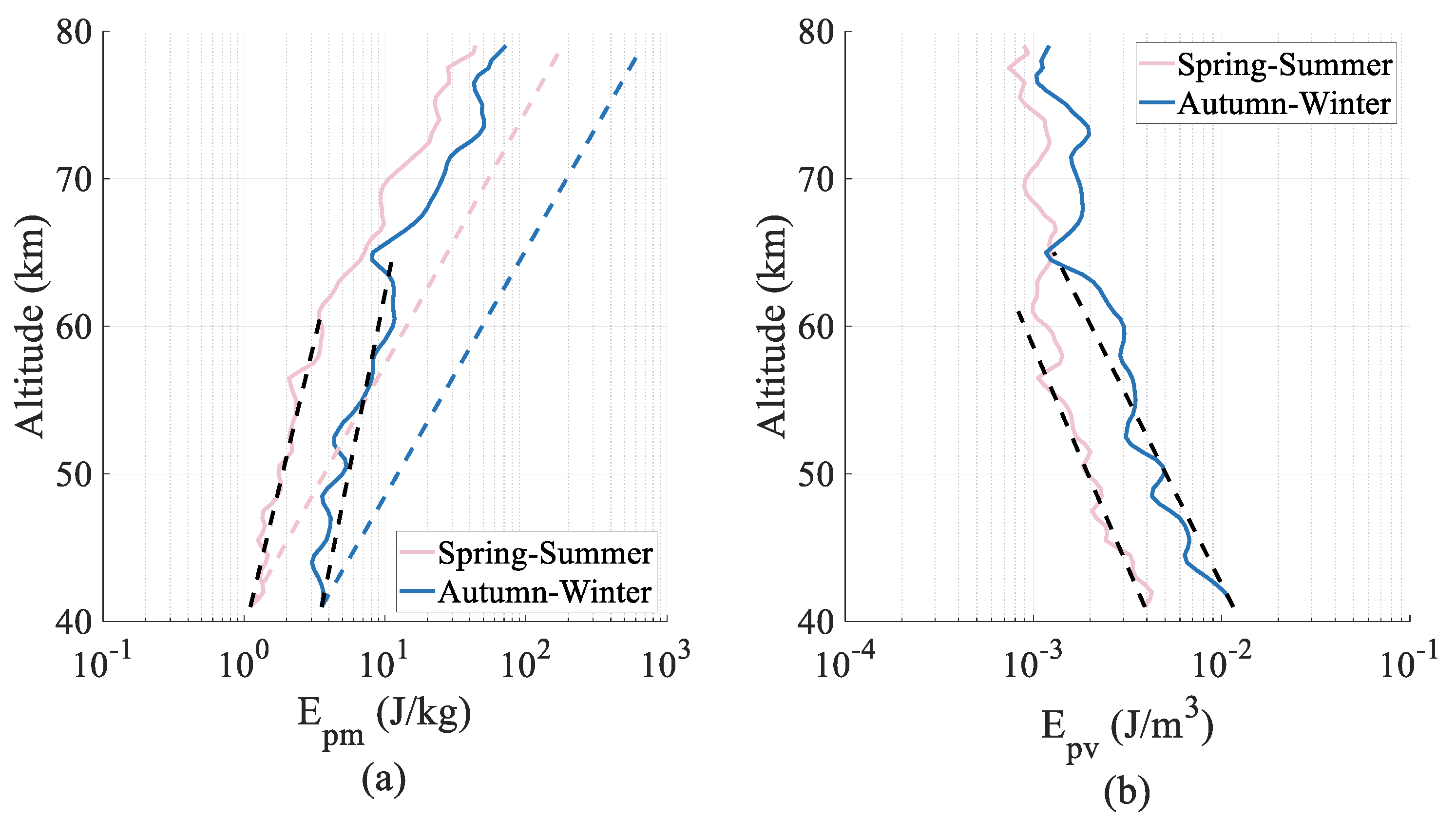
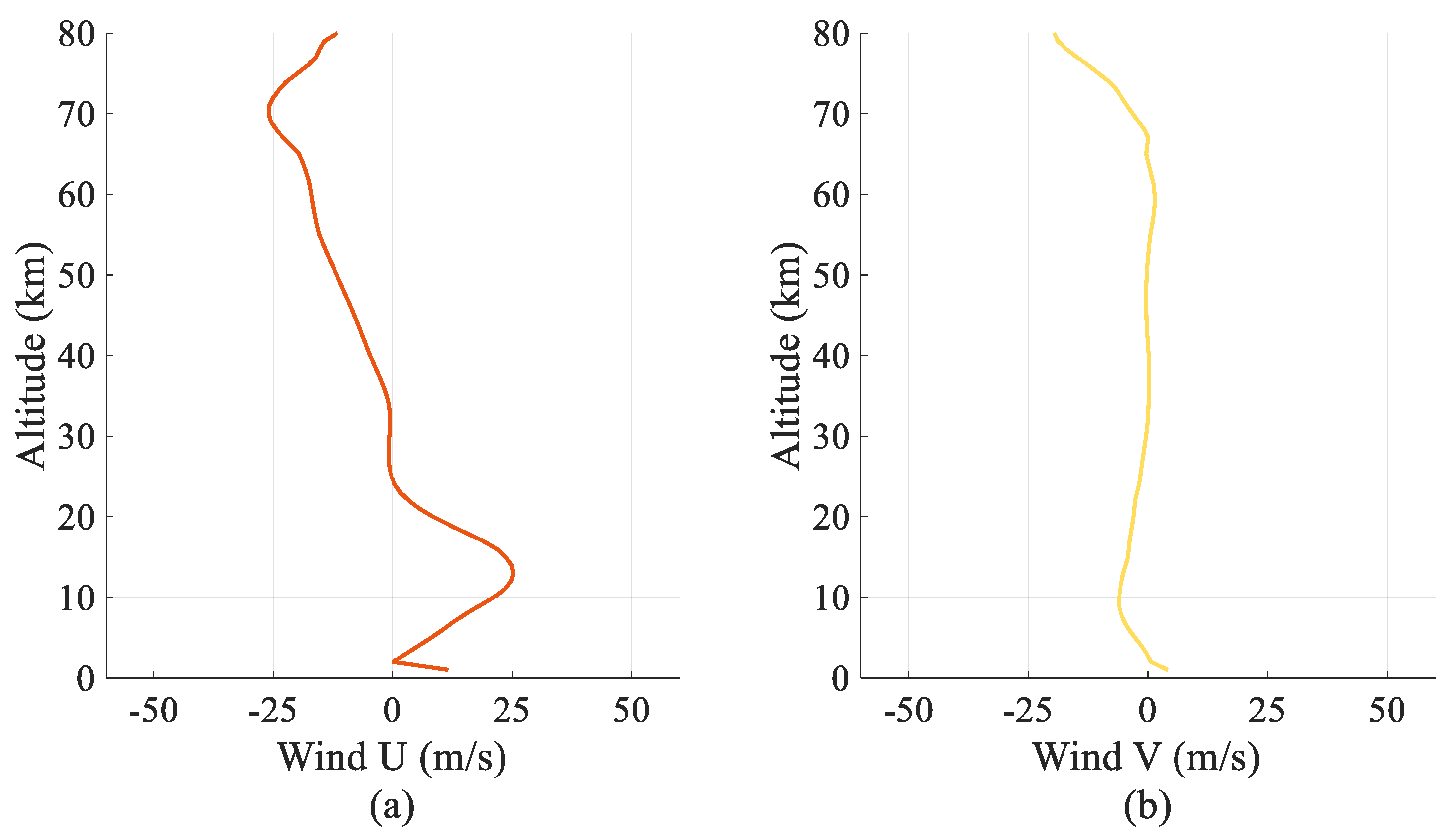
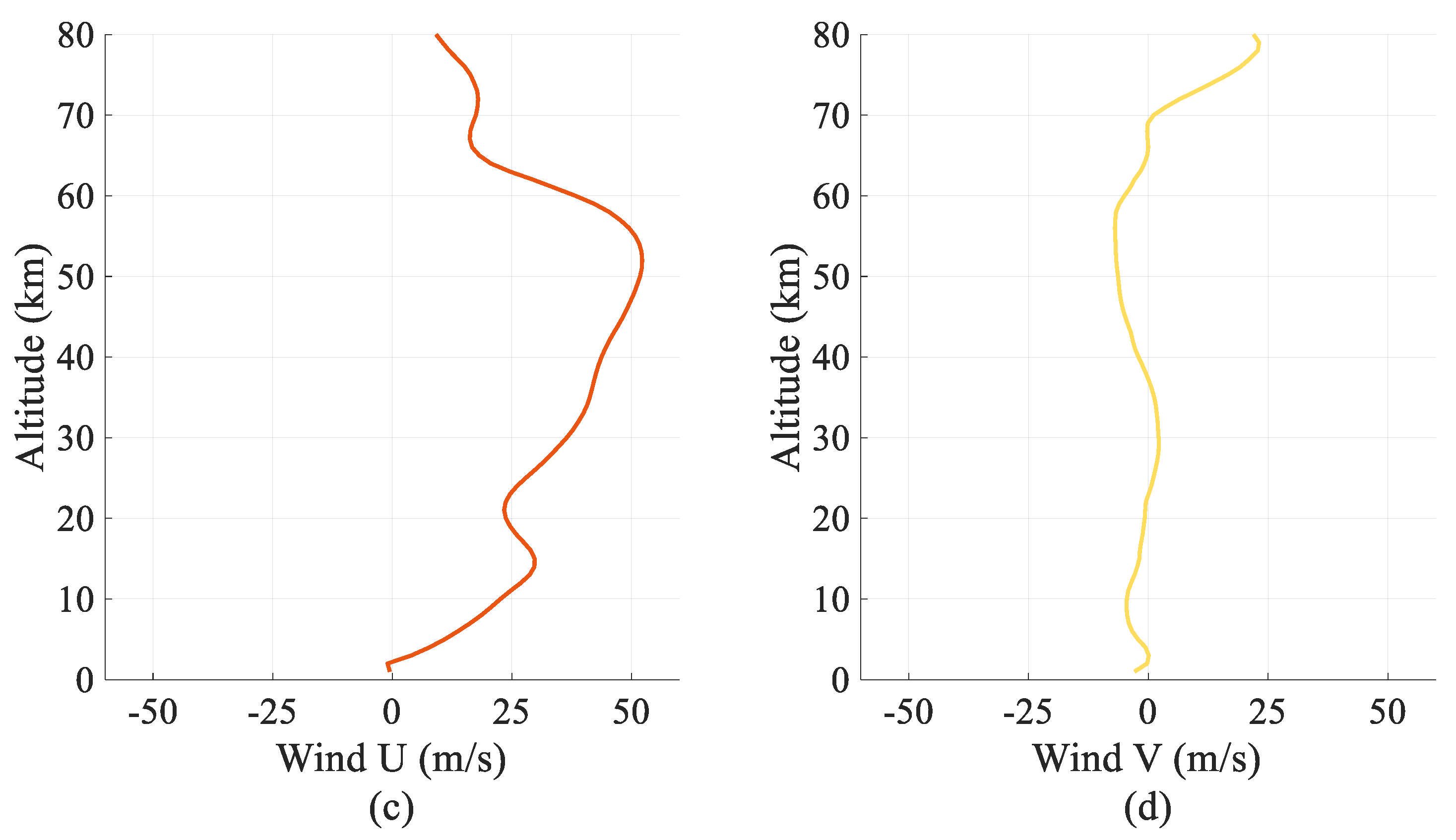
| Parameters | Value |
|---|---|
| Laser Wavelength/nm | 532 |
| Laser Power/W | 15 |
| Pulse Repeat Frequency/Hz | 30 |
| Pulse Duration/ns | 7 |
| Telescope Aperture/cm | 100 |
| Bandwidth of Interference filter/nm | 1.0 |
| 2019 | April | May | November | December | Total |
| Observations/days | 3 | 5 | 10 | 6 | 24 |
| Observation hours/h | 22 | 32 | 83 | 53 | 190 |
| 2020 | May | Jun | Nov | Total | |
| Observations/days | 11 | 4 | 16 | 31 | |
| Observation hours/h | 79 | 32 | 170 | 281 |
| Spring–Summer | Autumn–Winter | |
|---|---|---|
| (km) | 17.19 | 20.54 |
| (km) | 12.94 | 10.95 |
| (km) | 7.38 | 7.14 |
Publisher’s Note: MDPI stays neutral with regard to jurisdictional claims in published maps and institutional affiliations. |
© 2022 by the authors. Licensee MDPI, Basel, Switzerland. This article is an open access article distributed under the terms and conditions of the Creative Commons Attribution (CC BY) license (https://creativecommons.org/licenses/by/4.0/).
Share and Cite
Zhao, W.; Hu, X.; Yan, Z.; Pan, W.; Guo, W.; Yang, J.; Du, X. Atmospheric Gravity Wave Potential Energy Observed by Rayleigh Lidar above Jiuquan (40° N, 95° E), China. Atmosphere 2022, 13, 1098. https://doi.org/10.3390/atmos13071098
Zhao W, Hu X, Yan Z, Pan W, Guo W, Yang J, Du X. Atmospheric Gravity Wave Potential Energy Observed by Rayleigh Lidar above Jiuquan (40° N, 95° E), China. Atmosphere. 2022; 13(7):1098. https://doi.org/10.3390/atmos13071098
Chicago/Turabian StyleZhao, Weibo, Xiong Hu, Zhaoai Yan, Weilin Pan, Wenjie Guo, Junfeng Yang, and Xiaoyong Du. 2022. "Atmospheric Gravity Wave Potential Energy Observed by Rayleigh Lidar above Jiuquan (40° N, 95° E), China" Atmosphere 13, no. 7: 1098. https://doi.org/10.3390/atmos13071098
APA StyleZhao, W., Hu, X., Yan, Z., Pan, W., Guo, W., Yang, J., & Du, X. (2022). Atmospheric Gravity Wave Potential Energy Observed by Rayleigh Lidar above Jiuquan (40° N, 95° E), China. Atmosphere, 13(7), 1098. https://doi.org/10.3390/atmos13071098






